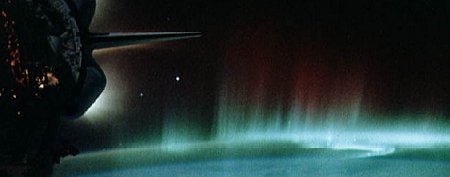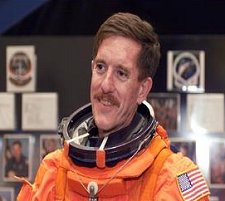|
Astronaut and explorer Jim Reilly tells what
it's like to do construction work in the far-out environment of
space.
by Karen Miller
Jim Reilly, astronaut: "One of my favourite
memories is hanging out with just one hand on the space station, and
then swinging out so I could look across the Earth. The atmosphere
is really transparent, so you can see a lot of detail on the surface
below. One time when I had a chance to hang out on the bottom of the
station, the
sunset was coming. I left my lights off so I could watch the Sun
go down. And as it went down, the stars started popping out. Of course
they don't twinkle. They're all different sizes, and even different
colours, in space... At night you can see lightning flashes from thunderstorms
on the surface down below. You can get this blue light flashing, and
in this case I was able to see it flashing off the bottom of the station.
And as I was watching all this, we flew through the edges of the aurora,
kind of green and white curtains as we flew past."
"It was pretty spectacular," he added with a degree
of understatement.
Space walking astronauts like Reilly can't afford
to be star-struck, though. They do a dangerous job that requires
concentration. Floating two hundred miles overhead where a careless
motion could send them spinning into the void, modern-day astronauts
connect power lines, deploy antennas, haul supplies. They service
satellites and bolt modules to the space station. They're construction
workers, points out NASA engineer Phil West.
On Earth, most construction workers need little
more than a hardhat for protection. They can move their arms anywhere
they want. And if they drop something, it doesn't drift away.
In space, all that changes.
The thing that Jim Reilly was always most conscious
of, he recalls, was the need to slow down his motions. The astronauts
train in water, explains Reilly, who's flown two missions, and who
last summer installed an airlock on the International Space Station
(ISS). That training accustoms them to weightlessness. But water
is not the same as space. Unlike vacuum, water is dense; it pushes
back. "The water helps dampen your movements,” says Reilly.
"You can do things that if you did them in outer space, you would
go out of control."

more
Orbiting
hundreds of kilometers above Earth, the space shuttle sometimes
glides right through spectacular auroras. Astronauts on
board Space Shuttle Discovery captured this image in 1991.
|
If you turn a bolt, for example, you
must remember there is no water to hold you in place, and that you
can push yourself off pretty fast if you don't pay attention. "You
learn," he says, "to bring yourself to a stop, and then make yourself
motionless, without any momentum remaining. Then, you can do whatever
needs to be done." You always have to think, he says, do I need
to do this task a little slower?
But it's not only weightlessness that
the astronauts deal with. The space suit itself forces astronauts
to adjust some deeply ingrained habits. The suit is pressurized
to 4.3 psi (pounds per square inch). That's less than one-third
of the pressure of Earth's atmosphere at sea-level (14.7 psi). The
air pressure outside a airplane flying at 35,000 feet is near 4.3
psi. It's also about the same as the extra pressure that keeps a
football inflated, says Reilly. And, like a football, the suit is
hard to bend.

The inflated
arms and bulky gloves of a space suit render some motions
- like reaching to the side and grabbing small objects -
unfamiliar and difficult.
|
To make it easier for astronauts to
move, the suit's engineers designed in joints: elbows, shoulders,
knees. But those joints can offer only a limited range of motion.
That means, Reilly explains, that in
space you can only work in the approximately three foot by three
foot by one foot area directly in front of you. It takes some getting
used to. "When you start your training, you have to start thinking
about the different ways you need to manoeuvre to get to the different
positions," says Reilly. "There are certain moves that you don't
want to try, because you'll be working against the suit."
For example, let's say that you wanted
to grab an object off to the side. You wouldn't just reach out for
it, like you would on Earth. The shoulder joint rotates front to
back - not side to side. You could move your arm sideways by bending
the inflated arm of the suit. That's not impossible, notes Reilly,
but it does take some effort. It's easier to rotate your body until
you're facing the object and then reach it by moving your arm forward.
The gloves, Reilly says, are one place
where the pressure is especially noticeable. They're designed so
that there's little strain when your hand is at rest, but as a result,
when you open your hand, you push against the resistance of the
glove. To understand the effort involved, Reilly suggests this exercise:
Close your hand, put a rubber band around your fingers, and then
open your hand fifteen times as far as it will go. The strain on
the muscles in your forearm, he says, is exactly the same as in
space.

Astronaut
Jim Reilly, mission specialist, is pictured at the Johnson
Space Center in February 2001
|
There's more, of course. You can't whistle
in a spacesuit, because the air pressure's too low. Tools must be
two to three times larger than normal because the gloves are so bulky.
You hear the constant loud whine of the fan that circulates the atmosphere
within the suit. But you adapt. The suit became very comfortable,
says Reilly, and wearing it began to feel like second nature to him.
"As we were getting ready for our first EVA, Yury
Usachev, who was commander of Expedition Two [on the ISS], came
by. We were chatting about suit use, and things to watch out for.
He just wanted to make sure that we were aware that it's very very
dangerous outside. And it is. We were always conscious of that.
But he said one thing at the end: 'In spite of all that, when you're
working, just make sure you take a couple of seconds to just look
up every once in a while, and look around.'
"That was the best piece of advice he gave me,"
says Reilly. "Because every once in a while, just for 10 seconds,
I'd stop and look around, and see what part of the planet I was
over, and look at the horizon . . .it was really a joy to do that
work. I hope I get a chance to do it again"
|
